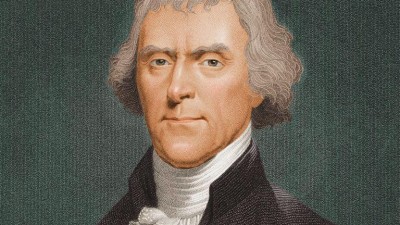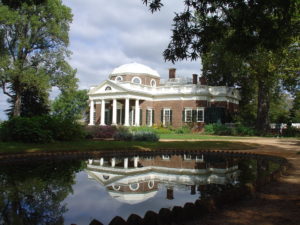Was Thomas Jefferson a Rapist?

On President’s Day, The Washington Post published a front-page article about Thomas Jefferson’s mansion, Monticello, finally restoring Sally Hemings’s room, which was next door to Jefferson’s bedroom, a further grudging acknowledgement that Hemings was his concubine.
But the Post could not bring itself to state the obvious. It described Jefferson imposing himself sexually on his female slave as a “relationship,” rather than a serial rape that apparently began when Hemings was around 14 years of age.
The Post reported that in 1941, the caretakers of Monticello transformed Hemings’s room into a restroom as “the floor tiles and bathroom stalls covered over the story of the enslaved woman, who was owned by Jefferson and had a long-term relationship with him.”
But – as grotesque as it may be to erase her room by installing toilets – it is equally grotesque to describe as a “relationship” an older powerful man having sex with a young female slave who had little choice but to submit to his predations and bear his children.
It may be hard for the American people to accept but the evidence increasingly indicates that the author of the Declaration of Independence and the third president of the United States was a pedophile and a rapist.
That is the story that Jefferson’s many apologists have most desperately tried to obscure along with his wretched record on race, including the sickening racism in his Notes on the State of Virginia, that includes his pseudo-science of assessing physiological and mental traits of African-Americans to prove that all men were not created equal.
For generations, the apologists also have challenged slave Sally Hemings’s late-in-life remembrance to one of her sons, Madison Hemings, describing how Jefferson had imposed himself on her sexually in Paris after she arrived in 1787 as a teen-age slave girl attending one of his daughters.
According to Madison Hemings’s account, his mother “became Mr. Jefferson’s concubine [in Paris]. And when he was called back home she was enciente [pregnant] by him.” Jefferson was insistent that Sally Hemings return with him, but her awareness of the absence of slavery in France gave her the leverage to insist on a transactional trade-off; she would continue to provide sex to Jefferson in exchange for his promise of good treatment and the freedom of her children when they turned 21, Madison Hemings said.
Smearing Hemings
The traditional defense of Jefferson was to portray Sally Hemings as a promiscuous vixen who lied about her relationship with the Great Man to enhance her humble standing. After all, whose word would you believe, that of the estimable Jefferson who publicly decried race mixing or a lowly African-American slave girl?
For decades, the defenders stuck to that dismissive response despite the curious coincidence that Hemings tended to give birth nine months after one of Jefferson’s visits to Monticello and the discovery of male Jefferson DNA in Hemings’s descendants.
Still, the Jefferson apologists raised finicky demands for conclusive proof of the liaison, as if it were absurd to envision that a relatively young man then in his mid-40s, a widower since his wife died in 1782, would have initiated a sexual relationship with an African-American female, even an attractive light-skinned mulatto like Hemings (who was the illegitimate daughter of Jefferson’s father-in-law and thus Jefferson’s late wife’s half-sister).
Though it’s true that unequivocal evidence does not exist — Hemings did not save a semen-stained blue dress so it could later be subjected to DNA analysis — historians have increasingly come to accept the reality of Jefferson’s sexual involvement with his young slave girl who was only 14 when she moved into Jefferson’s residence in Paris.
So, with this ground shifting under Jefferson’s defensive lines, his apologists retreated to a new position, that the relationship was a true love affair and/or that Jefferson’s behavior fit with the moral behavior of the times as slave owners frequently raped their female slaves (and thus Jefferson’s behavior should not be judged adversely).
Hemings was transformed into a kind of modern-day independent woman making her own choices about matters of the heart. However, given her age and her status as Jefferson’s property the relationship could be more accurately described as serial rape.
But the reality may be even worse. Recent historical examinations of records at Jefferson’s Monticello plantation have provided support for contemporaneous accounts of Jefferson having sex with at least one other slave girl beside Hemings and possibly more.
Fathering of Slaves
Some scholars, such as historian Henry Wiencek in his 2012 book, Master of the Mountain: Thomas Jefferson and His Slaves, give credence to old reports about Jefferson having a direct role in populating Monticello by fathering his own dark-skinned lookalikes.
“In ways that no one completely understands, Monticello became populated by a number of mixed-race people who looked astonishingly like Thomas Jefferson,” wrote Wiencek. “We know this not from what Jefferson’s detractors have claimed but from what his grandson Jeff Randolph openly admitted. According to him, not only Sally Hemings but another Hemings woman as well ‘had children which resembled Mr. Jefferson so closely that it was plain that they had his blood in their veins.’
“Resemblance meant kinship; there was no other explanation. Since Mr. Jefferson’s blood was Jeff’s blood, Jeff knew that he was somehow kin to these people of a parallel world. Jeff said the resemblance of one Hemings to Thomas Jefferson was ‘so close, that at some distance or in the dusk the slave, dressed in the same way, might be mistaken for Mr. Jefferson.’”
During a dinner at Monticello, Jeff Randolph recounted a scene in which a Thomas Jefferson lookalike was a servant tending to the table where Thomas Jefferson was seated. Randolph recalled the reaction of one guest: “In one instance, a gentleman dining with Mr. Jefferson, looked so startled as he raised his eyes from the latter to the servant behind him, that his discovery of the resemblance was perfectly obvious to all.”
In the 1850s, Jeff Randolph told a visiting author that his grandfather did not hide the slaves who bore these close resemblances, since Sally Hemings “was a house servant and her children were brought up house servants so that the likeness between master and slave was blazoned to all the multitudes who visited this political Mecca” and indeed a number of visitors did make note of this troubling reality.
Even Jefferson admirer Jon Meacham accepted the truth of the Hemings liaison in Thomas Jefferson: The Art of Power. Meacham cited a quote from Elijah Fletcher, a visitor from Vermont: “The story of Black Sal is no farce — That he cohabits with her and has a number of children by her is a sacred truth and the worst of it is, he keeps the same children slaves an unnatural crime which is very common in these parts This conduct may receive a little palliation when we consider that such proceedings are so common that they cease here to be disgraceful.”
Meacham observed that Jefferson “was apparently able to consign his children with Sally Hemings to a separate sphere of life in his mind even as they grew up in his midst.
“It was, to say the least, an odd way to live, but Jefferson was a creature of his culture. ‘The enjoyment of a negro or mulatto woman is spoken of as quite a common thing: no reluctance, delicacy or shame is made about the matter,’ Josiah Quincy Jr. of Massachusetts wrote after a visit to the Carolinas. This was daily reality at Monticello.”
Family Doubts
This “daily reality” was also a troubling concern among Jefferson’s white family though the Great Man would never confirm or deny his parentage of a number of Monticello’s slaves.

In the Broadway musical “Hamilton,” actor Daveed Diggs (left) who played Thomas Jefferson (as something of a hypocrite) and the musical’s creator Lin-Manuel Miranda, who played Alexander Hamilton (who was Jefferson’s adversary during the first years of the Republic).
“Frigid indifference forms a useful shield for a public character against his political enemies, but Jefferson deployed it against his own daughter Martha, who was deeply upset by the sexual allegations against her father and wanted a straight answer Yes or no? an answer he would not deign to give,” wrote Wiencek.
Before his death, Jefferson did free several of Sally Hemings’s children or let them run away presumably fulfilling the commitment made in Paris before Hemings agreed to return to Monticello to remain his slave concubine.
“Jefferson went to his grave without giving his family any denial of the Hemings charges,” Wiencek wrote.
The historical record increasingly makes Jefferson out to be a serial rapist, exploiting at least one and possibly more girls who were trapped on his property, who indeed were his property, and thus had little choice but to tolerate his sexual advances.
Whipping the Children
The evidence of Jefferson’s sexual predations must also be viewed in the context of his overall treatment of his slaves at Monticello. Though Jefferson’s apologists pretend that he was a kind master distressed over the inequities of a slave system that he could somehow neither correct nor escape, the latest evidence much of it concealed for generations to protect Jefferson’s image reveal him to be a cruel slave-owner who carefully calculated the net worth that his human chattel provided him and having boys as young as 10 whipped.
Some of Jefferson’s mistreatment of his slaves derived from another of his hypocrisies, his views about simplicity and solvency. As historian John Chester Miller wrote in his 1977 book, The Wolf by the Ears, “To Jefferson, the abandon with which Americans rushed into debt and squandered borrowed money upon British ‘gew-gaws’ and ‘trumpery’ vitiated the blessings of peace.
“From Paris an unlikely podium from which to sermonize Jefferson preached frugality, temperance, and the simple life of the American farmer. Buy nothing whatever on credit, he exhorted his countrymen, and buy only what was essential. ‘The maxim of buying nothing without money in our pocket to pay for it,’ he averred, ‘would make of our country (Virginia) one of the happiest upon earth.’
“As Jefferson saw it, the most pernicious aspect of the postwar preoccupation with pleasure, luxury, and the ostentatious display of wealth was the irremediable damage it did to ‘republican virtue.’”
But Jefferson himself amassed huge debts and lived the life of a bon vivant, spending way beyond his means. In Paris, he bought fancy clothes, collected fine wines, and acquired expensive books, furniture and artwork. It was, however, his slaves back at Monticello who paid the price for his excesses.
“Living in a style befitting a French nobleman, his small salary often in arrears, and burdened by debts to British merchants which he saw no way of paying, Jefferson was driven to financial shifts, some of which were made at the expense of his slaves. In 1787, for example, he decided to hire out some of his slaves a practice he had hitherto avoided because of the hardship it wreaked upon the slaves themselves,” Miller wrote.
Exploiting His Slaves
Upon returning to the United States, Jefferson reinvented himself as a more modestly attired republican, but his tastes for the grandiose did not abate. He ordered elaborate renovations to Monticello, which deepened his debt and compelled his slaves to undertake strenuous labor to implement Jefferson’s ambitious architectural designs.

Thomas Jefferson, the principal author of the Declaration of Independence and the third president of the United States.(in a 1788 portrait by John Trumbull, credit: Thomas Jefferson Foundation)
Needing to squeeze more value from his slaves, Jefferson was an aggressive master, not the gentle patrician that his apologists have long depicted.
According to historian Wiencek, Jefferson “directed his manager, Nicholas Lewis, to extract ‘extraordinary exertions’ of labor from the slaves to stay current with his debt payments. Some slaves had endured years of harsh treatment at the hands of strangers, for to raise cash, Jefferson had also instructed Lewis to hire out slaves. He demanded extraordinary exertions from the elderly: ‘The negroes too old to be hired, could they not make a good profit by cultivating cotton?’”
Jefferson was callous as well toward his young slaves. Reviewing long-neglected records at Monticello, Wiencek noted that one plantation report to Jefferson recounted that the nail factory was doing well because “the small ones” ages 10, 11 and 12 were being whipped by overseer, Gabriel Lilly, “for truancy.”
His plantation records also show that he viewed fertile female slaves as exceptionally valuable because their offspring would increase his assets and thus enable him to incur more debt. He ordered his plantation manager to take special care of these “breeding” women.
“A child raised every 2. years is of more profit than the crop of the best laboring man,” Jefferson wrote. “[I]n this, as in all other cases, providence has made our duties and our interests coincide perfectly.”
According to Wiencek, “The enslaved people were yielding him a bonanza, a perpetual human dividend at compound interest. Jefferson wrote, ‘I allow nothing for losses by death, but, on the contrary, shall presently take credit four per cent. per annum, for their increase over and above keeping up their own numbers.’ His plantation was producing inexhaustible human assets. The percentage was predictable.”
To justify this profiting off slavery, Jefferson claimed that he was merely acting in accordance with “Providence,” which in Jefferson’s peculiar view of religion always happened to endorse whatever action Jefferson wanted to take.
Part of that “Providence” presumably supplied him with comely slave girls such as Sally Hemings and allowed Jefferson to do his part in “breeding” his slave stock and assuring more compound profits from his investments.
Investigative reporter Robert Parry broke many of the Iran-Contra stories for The Associated Press and Newsweek in the 1980s. You can buy his latest book, America’s Stolen Narrative, either in print here or as an e-book (from Amazon and barnesandnoble.com).




